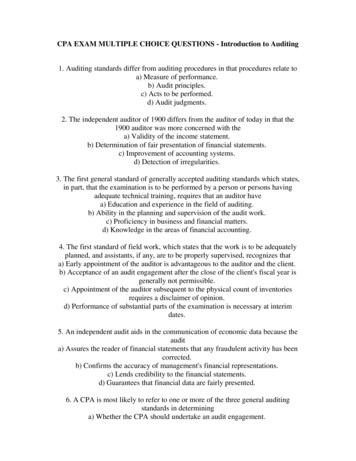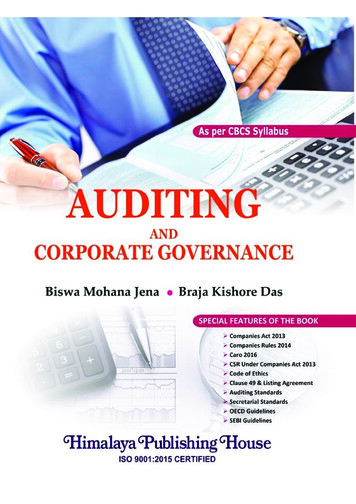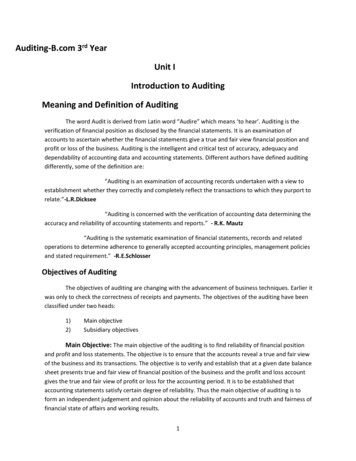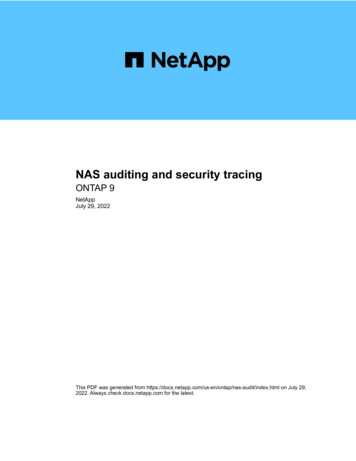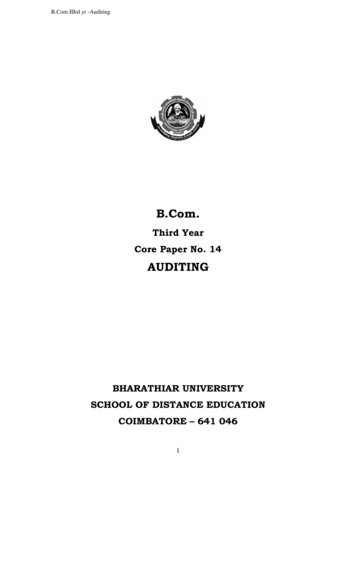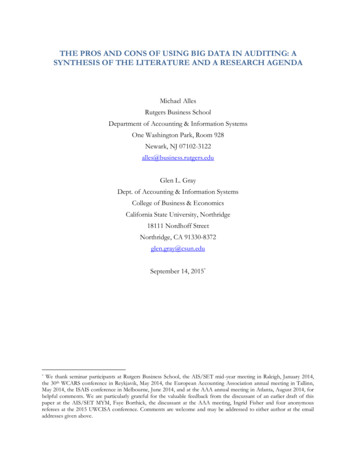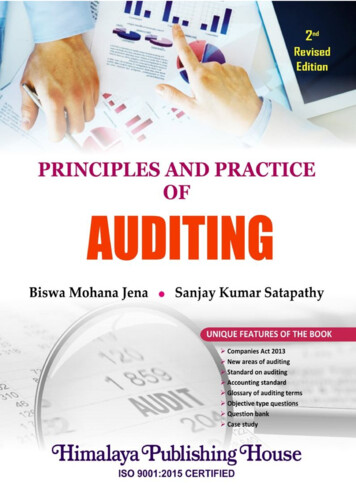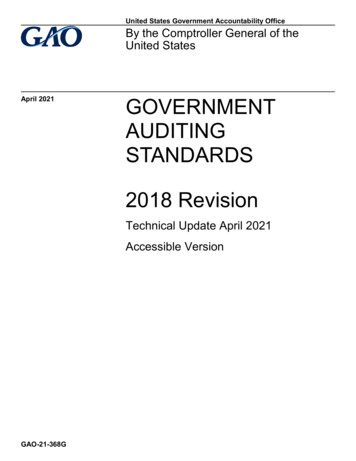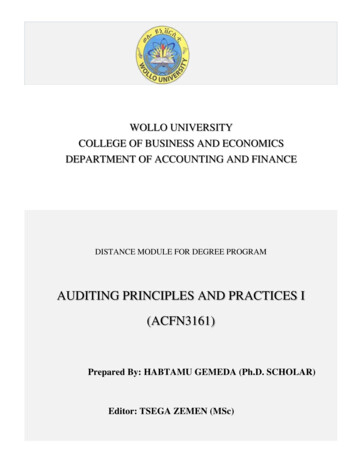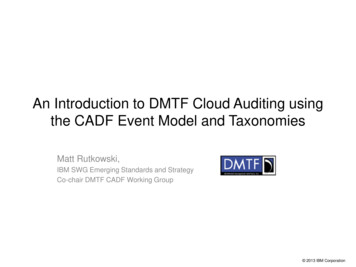
Transcription
An Introduction to DMTF Cloud Auditing usingthe CADF Event Model and TaxonomiesMatt Rutkowski,IBM SWG Emerging Standards and StrategyCo-chair DMTF CADF Working Group 2013 IBM Corporation
Cloud Auditing: Customer Importance: Self-Managing Auditing Data on CloudsCustomers will not trust clouds to host their workloads / data without the ability to self-auditAuditing using a standard such as CADF has many benefits: Create and request Customized Views for Audit & Compliance Data Key event data is Normalized and Categorized to support auditing of Hybrid Cloud Applications Track regional, industry and corporate policy compliance using standardized APIS / ReportsCADF assures consistent mappings across cloud components and cloud providersFormat is Agnostic to the underlying Provider Infrastructure Low-level operational processes not exposedWidget.comCloudProvider ASaaS ApplicationCloudProvider BWidget.comAuditorWidget.comComplianceToolsSaaS ApplicationHybrid ApplicationHybrid ApplicationCustomer Benefits Ability to Self Manage Auditing of their data Similar Reports from different Cloud Providers Aggregate Audit Data from Different Clouds / Partners Auditing Processes & Tools Unchanged 2013 IBM CorporationCloudProvider CHybrid Application2
Overview: Cloud Auditing Data Federation (CADF) StandardDevelop a normative audit event data model and compatible set of interfaces for federating events,logs and reports between cloud providers and customers Use extensible classification systems for real or virtual cloud-based IT resources and theirinteractions to support cross-cloud / hybrid cloud analysis allowing universal query of event dataKey Participants: IBM, NetIQ, Microsoft, CA, Huawei, VMware, Fujitsu, Citrix, EMCWork Products Published: “Use Cases Whitepaper v1.0”, Public Draft, July, 2012 Released: “Data Model and Interface Specification, v1.0b”, Public Draft 2, June 2013 Added RESTful Query Interface finalized (Customer Self Management), Added support for “Control Event Type” to support linkage to customer policies Added support for Event “Tags” to support customer & domain-specific views on data Added support for “Complex Targets” (multiple heterogenous/homogenous)Current Work Target October 2013: v1.0c Specification Draft for review. Last scheduled v1.0 draft before “final” v1.0 status is sought from DMTF companies. Incorporates updates based upon integration work with OpenStack3“As audit and compliance concerns grow for cloud-based applications or cloud-inclusive workflows, theimportance of interoperability becomes more evident.” 2013 IBM Corporation
Key Features - of CADF Standard over Existing / Legacy FormatsStandardized Classification of Event Data using Extensible Taxonomies Resources – By the role played in the event (Initiator, Target, Observer, etc.)Actions – No confusion between events with similar sounding activities.Outcomes – Well-defined and unambiguous results for all activitie types.Federation of Events Data from Hybrid Deployments Tagging – Customers can create Orthogonal Views via Path-based Tagging Resource Identity – Resources uniquely tracked via UUIDs, not dependent on relative IP addresses.Timezone-Aware - Specifies how to create events from different Timezones and track any record changesGeolocation Aware – Track geolocation of resources using International Standards Ability to identify and track multiple Domains of Interest from same event data e.g. PCI, SoX, Local Corporate Policy, Regional Policy, Departmental Policy, etc.Proving enforcement of Regional Policies for data and application hostingEvent Merge – Instantly merge CADF event data from any hybrid deployment into consistent end-to-end logsSelf-Service, REST-based APIs for Log Management and Audit Standardized Query using Standardized Path-based Expressions Construct reports from any attribute within CADF data schema More than tracking Source, Target (IP Addresses) and timestamps (geolocs, resource types, policies, etc.) Beyond Access or Activity Reports4 Defines Metric (e.g., usage and performance data) and Control events that map to external policies(security, operational, business, or other). Metrics and Measurement data are compliant with NIST metric standards (in development) 2013 IBM Corporation
OpenStack Integration – API Auditing using the CADF Model, JSON FormatOpenStack Based Cloud ProvidersProject Ceilometer OpenStack’s Aggregator of Performance andUsage Metrics Delivered API Audit “Plug-in”:– in “Havana” Release 4Q 2013– Fully tested for Nova (compute)– Works for any component, including: Network(Neutron), Storage (Cinder), etc.and Growing IaaS LayerOpenStack API Clients1Core API Layer“Filter” audits all OpenStack API calls2CADFStandardizedCeilometerUsage / PerformanceMonitoring AuditingOpenStack Integration (Completed)1“Audit filter” in Core Components APIsgenerate audit data in CADF format2Ceilometer receives data from agentsand filters listening to core components.3Ceilometer dispatches event data usingCADF format to one or more“datastores”.4Dispatchers can be added to send CADFaudit data to other services for analysis.34“Other services” EventCorrelation“Datastores”IBM authored OpenStack DriversIBMCloudHardwarezSeriesSystem PSystem xOpenStack is IBM’s Strategic IaaS Platform for SmartCloud5OpenStack Core API Specs: t Ceilometer: https://wiki.openstack.org/wiki/Ceilometer 2013 IBM Corporation
CADF Event Model ComponentsEvent model is common to all CADF Event Types (i.e. “activity”, “monitor” and “control”)Conceptual ModelModel ComponentsCADF Event ModelComponentDefinitionOBSERVERThe RESOURCE that generates the CADF Event Record basedon its observation (directly or indirectly) of the Actual Event.INITIATORThe RESOURCE that initiated, originated, or instigated the event'sACTION, according to the OBSERVER.ACTIONThe operation or activity the INITIATOR has performed, attempted toperform or has pending against the event's TARGET, according tothe OBSERVERTARGETThe RESOURCE against which the ACTION of a CADF EventRecord was performed, was attempted, or is pending, according tothe OBSERVER.OUTCOMEThe result or status of the ACTION against the TARGET, accordingto the OBSERVER.CADF specification and Event Model are extensible New “event types” can be defined for other domains that extend this modelProfiles of the base spec. can be published to describe proper use in other domains 2013 IBM Corporation6
“CSI for Clouds” - How CADF standard expresses the 7 “W”s of audit and compliance“W”ComponentCADF MandatoryComponentCADF Optional Components(where nt.reason (e.g. severity, reason code, policyid)“what” activity occurred; “what” wasthe resultWhenevent.eventTimereporter.timestamp(for each reporter that modifies the record)“when” did it happenWhoinitiator.idinitiator.typeInitiator.id (id, name): (basic)initiator.credential (token): (detailed)initiator.credential.assertions (precise)“who” (person or service) initiated theactionOnWhattarget.idtarget.type“onWhat” resource did the e” did the activity get (observed)loggedFromWhereinitiator.addresses (basic)initiator.host (agents, platforms, ) (detailed)Initiator.geolocation (precise)ToWheretarget.addresses (basic)target.host (agents, platforms, ) (detailed)target.geolocation (precise)CADF provides methods to “Extend” the event data (format) to carry domain-specific informationCADF ExtensionTypeCADF Optional ComponentPurposeAttachmentevent.attachmentsFor adding domain specific structured or unstructured data. If structured,the type can be supplied and referenced by the CADF Query API.Tagsevent.tagsFor adding domain-specific identifiers and classifications that enabledomain specific identification and can be used with the CADF Query APIto construct custom reports. 2013 IBM Corporation7
CADF Event Model – The “Reporter Chain”Cloud provider architectures are generally layered in a way such that many Actual Events may occur at the lower layers, whichare close to the infrastructure components and services. Additionally, operational systems and processes may span many layersof the architecture, each with critical information that would be valuable to associate with audit events.The CADF Event Model recognizes that many components may assist in constructing and surfacing the CADF Event Recordbefore it is presented to the end consumer. These components can each be viewed as CADF Event Record REPORTERS eachserving a specified role in raising the CADF Event Record as part of a sequential chain of REPORTER components.Valid Roles for a REPORTER resourceReporter RoleCADF DefinitionobserverA REPORTER that fulfills the role of OBSERVER.modifierA REPORTER that adds, modifies or augments information in the CADF Event Record for the purposes ofnormalization or federation.relayA REPORTER that passes the CADF Event Record to another REPORTER or to end record consumer withoutmodifying the information in the CADF Event Record.Conceptual “chain” of reporters that may “handle” the event record before reaching the consumer rce 2013 IBM Corporation8
Additional Event Model Components: Measurements and MetricsMeasurements are an optional component of the CADF Event Type, but are essential (required) for any CADF EventRecord that is classified as a "monitor" type event.Event ComponentCADF DefinitionMEASUREMENTAn entity that contains statistical or measurement information for the TARGET resource(s) that are being monitored. Themeasurement should be based upon a defined metric (a method of measurement).Metric data typeThe Metric data type describes the rules and processes for measuring some activity or resource, resulting in the generation of some values (captured by theMeasurement type). A set of metric instances may be associated with an Event Log, and referred to by individual :IdentifierYesThe identifier for the metric (allows reuse)Metric data is designed so that it can be described once, for example in the context of a CADF Log,and referenced by the multiple CADF Event (records) the log contains.unitxs:stringYesThe metrics unit (e.g., "msec.", "Hz", "GB", etc.)namexs:stringNoA descriptive name for metric (e.g., “Response Time in Milliseconds", "Storage Capacity in Gigabytes",etc.)annotationscadf:MapNoUser-defined metric information.The same “key” SHALL NOT be used more than once within a "annotation" property.Measurement data typeThe Measurement type is intended to hold the values generated by the application of a metric in a particular context (e.g., for a resource or during an activity).The CADF Event Record includes a property that is capable of holding measurements represented by this nThe quantitative or qualitative result of a measurement from applying the associated metric. Themeasure value could be boolean, integer, double, a scalar value, etc.metriccadf:MetricOptionalThe property describes the metric used in generating the measurement result (if no “metricId”property is provided)metricIdcadf:IdentifierOptionalThis property identifies a CADF Metric by reference and whose definition exists outside theevent record itself (e.g., within the same CADF Log or Report).calculatedBycadf:ResourceNoAn optional description of the resource that calculated the measurement 2013 IBM Corporation9
Additional Event Model Components: GeolocationGeolocation information reveals a resource’s physical location and can be obtained through various technologies.It is widely used in context-sensitive content delivery, enforcing location-based access restrictions on services, and frauddetection and prevention along with addressing concerns regarding security and privacy especially in countries/regionswith compliance legislation and regulation. It is crucial to report geolocation information unambiguously in an audit trail.Geolocation data :DescriptionOptional identifier for a geolocation.Indicates the latitude of a geolocation. Geolocation MAY be provided in a pair of latitude and longitude.Latitude values adhere to the format based on ISO 6709:2008Indicates the longitude of a geolocation. Geolocation MAY be provided in a pair of latitude and longitude.Longitude values adhere to the format based on ISO 6709:2008Indicates the elevation of a geolocation in meters.Elevation at or above the sea level shall be designated using a plus sign ( ), or no sign. Elevation belowthe sea level shall be designated using a minus sign ( ).Indicates the accuracy of a geolocation in meters. Geolocation expresses the resource location to areasonable degree of accuracy.Indicates the city of a geolocation.Indicates the state/province of a geolocationIndicates a region (e.g., a country, a sovereign state, a dependent territory or a special area ofgeographical interest) of a geolocation.The value used to indicate the region SHOULD match the ICANN country code top level domain (ccTLD)naming convention [IANA-ccTLD].Indicates user-defined geolocation information (e.g., building name, room number).The same “key” SHALL NOT be used more than once within a "annotation" property."geolocation": {"latitude": " 37.37","longitude": "-122.04","elevation": "10"} 2013 IBM CorporationXMLExample: geolocationcity "Sunnyvale"state "CA"regionICANN "us" annotation key ”building” value "B2"/ annotation key ”room” value "201"/ /geolocation 10
CADF Query Interface and Syntax (basics)Query Interface : implementations only require a “filter” parameter:? filter expressionQuery Syntax: “filter” parameter defines an “XPath like” :: :: :: :: :: :: IndexValueAndExpr ( 'or' Filter )* ;Comp ( 'and' AndExpr )*Attribute Op Value Value Op Attribute '(' Filter ')'' ' ' ' ' ' ' ' ' ' '! '? property name ? PropertyPath? property name ? ? property name ? “[” Index “]” ? property name ? “/” PropertyPath ? property name ? “[” Index “]” “/” PropertyPath:: '*' IntValue:: IntValue DateValue StringValue BoolValue PathValuePathValuePValue:: “ PValue “ ‘ PValue ‘:: StrValue StrValue “/” PValue StrValue “//” PValue “//” PValue ue:: :: :: :: :: /[0-9] /? as defined by XML Schema ?"StrValue" 'StrValue'? character string without “ nor ‘ ?'true' 'false'Query Syntax: Operators'or', 'and'' ', ' ', ' ', ' ', " ', '! '' ', '! ': Boolean value/attribute: Integer and date value/attribute: String value/attributeExample: “Time query window”To search for events that occurred on or after 2012-07-22:/events/Event? filter eventTime ”2012-07-22T00:00:00-02:00” 2013 IBM Corporation11
CADF Path-Based, Extensible TaxonomiesCADF defines three taxonomies designed to provide the basis for a domain extensible, path-based mechanism to name resources, actionsand that appear in audit events in order to enable normative classification and query of events data.1.CADF Resource Taxonomy Normalized classification type “names” for the resource types that participate on an event(e.g. INITIATOR, TARGET, REPORTER) Enables Resource-based Query by type of resource2.CADF Action Taxonomy Normalized names used to describe actions or activities performed on resources Enables Activity-based Query3.CADF Outcome Taxonomy Normalize the names used to describe outcomes of activities Enables Outcome-based QueryTo assure every “name” in a taxonomy is unique when federated, each value is assumed to have the following impliedabsolute domain namespace:Taxonomy NameTaxonomy as.dmtf.org/cloud/audit/1.0/taxonomy/outcome/All taxonomies are extensible for any domain-specific compliance framework 2013 IBM Corporation12
CADF Logical Resource Taxonomy - Classification MethodologyTaxonomy logical names can represent resources that may overlap cloud Infrastructure, platform &software service deployment models depending on provider architectureThe diagram attempts to convey that resources that may be named under these top-level nodes canrepresent resources some providers may consider more "infrastructure oriented" and offer as via anIaaS service model, whereas other providers may consider more "platform oriented" and offer them viaPaaS or SaaS service models. 2013 IBM Corporation13
CADF Logical Resource Taxonomy - Top-Level Classifications DefinitionsThis diagram shows the top-level resource classifications as child nodes under the "resource" node of the CADF ResourceTaxonomy's classification tree:resourceResource Namesstoragecompute* networkMore Infrastructure OrienteddataservicesystemMore Platform / Software l resources that represent storage containersLogical resources that are used to perform logical operations or calculations on dataLogical resources that interconnect computer systems, terminals, and other equipment allowing information to be exchanged.dataLogical named sets of information (objectified data) that are referenced and managed by services.serviceLogical set of operations, packaged into a single entity, that provides access to and management of cloud resources (for a givendomain).Logical resources that are a combination of several other [cloud] resources that operate as a functional whole, this combinationbeing manageable (created, operated, audited, etc.) as a unit i.e. offering some operations that could activate lower-leveloperations over each of the sub-resources.systemunknownIndicates that the OBSERVER of the event is not, to the best of its ability, able to classify a resource that contributed to theactual event it is reporting on using any other valid resource taxonomy value.Note: This value SHOULD only be used as a last resort, and when using another classification value from the CADF ResourceTaxonomy is not possible.Note: the name value “resource” (tree root) implies the absolute absolute name: y/resource/” 2013 IBM Corporation14
Storage tabasequeuecacheNameDescriptionnodeLogical resource that contains the necessary processing components to store data.volumeLogical unit of persistent data storage that is may or may not be physically removable from the computer or storage system.memoryLogical unit of data storage that is used for dynamically processing data.containerLogical unit of storage where data objects are deposited and organized for persistent storage.directoryLogical storage used to organize records about resources (e.g., files, subscribers, etc.) along with their locations and othermetadata. Typically, these records are organized in a hierarchical structure.databaseLogical storage used to organize data to a model (schema) that reflects relevant aspects of a specific real-world application.queueLogical storage of a list of data awaiting processing. 2013 IBM Corporation15
Compute DescriptionnodeLogical resource that contains the necessary processing components to execute a workload.cpuLogical resource that represents a unit processing power that can consume a workload.machineLogical resource that encapsulates both CPU and Memory.processAn instance of a granular workload, such as an application or service, that is being executed.threadA separable function of a running process that shares its virtual address space and system resources. 2013 IBM Corporation16
Network SubtreeNameDescriptionnodeA logical resource that can be networked and provide services on data from network connections. A node may exportzero or more endpoints (zero implies it is has not been provisioned).hostA network node that can perform operations or calculations on data.Note: Network “nodes” should not attempt to describe details of compute or storage functions; specific compute andstorage nodes exist that better suit this purpose).connectionA single network interaction involving two or more endpoints (sources and destinations).domainRepresents a logical grouping of networked resourcesclusterRepresents a logical combination of tightly coupled, network resources. 2013 IBM Corporation17
Service SubtreeNameDescriptive NameDescriptionossOperational SupportServices (OSS)The logical classification grouping for services that are identified to support operationsincluding communication, control, analysis, etc.bssBusiness Support Services The logical classification grouping for services that are identified to support business activities.(BSS)securitySecurity Services(or Sec-as-a-Service)The logical classification grouping for security services including Identity Mgmt., Policy Mgmt.,Authentication, Authorization, Access Mgmt., etc. (a.k.a. “Security-as-a-Service”)compositionComposition ServicesThe logical classification grouping for services that supports the compositing of independentservices into a new service offeringdatabaseDatabase Services(or DB-as-a-Service)Database services that permits substitutability to various provider implementations. 2013 IBM Corporation18
Service al services that ensure that the resource capacity allocated to an application (including compute, storage and networkingresources) matches its current utilization.configurationOperational services that manage and monitor configuration changes on applications to avoid incompatibilities that can result inreduced performance or compliance failures.loggingOperational services that capture or record information and identifying data about actions that occur in a system. This includes datathat could be or contribute to auditable event records,monitoringOperational services that monitor for ensure the availability of services and that they are provided in accordance with terms ofService License Agreements (SLAs).virtualizationOperational services that manage virtualization of compute, storage and network infrastructure.locationBusiness services to manage the location, physical or virtual, of cloud based resources as well as clients (e.g., mobile devices).billingBusiness services to manage different types of charges for cloud based resources relevant to a given customer.meteringBusiness Services to manage the measurement of cloud based resources (e.g., utilization, transactions, performance, etc.), often todetermine how to bill for service usage.orchestrationComposition services that automate the management of complex applications, services, platforms and/or infrastructures to alignthem to fulfill business and service agreements and operational policies.workflowComposition services that sequence connected steps that support management of a document (e.g., transaction, order, servicetemplate, etc.) through a complex system of applications, services, platforms and/or infrastructures.crmCustomer Relationship Mgmt. (CRM) Services (example extension of the “bss” classification)erpEnterprise Risk Mgmt. (ERM) Services (example extension of the “bss” classification)srmService Request Mgmt. (SRM) Services (example extension of the “bss” classification) 2013 IBM Corporation19
CADF Action TaxonomyValueDescriptioncreateThe target resource described in the event was created (or an attempt was made to do so) by the initiator resource.readData was read from the target resource by the initiating resource (or an attempt was made to do so).updateOne or more of the target resource's properties were modified or changed by the initiator resource.deleteThe target resource described in the event was deleted (or an attempt was made to do so) by the initiator resource.backupThe target resource described in the event is being persisted to storage without regard to environment, context or state at the time of storage.captureThe target resource described in the event is being persisted to storage along with relevant environment and state information (e.g. program settings, network state,memory/cache, etc.). Conceptually, a “snapshot” of the resource is being captured at a moment in time.configureThe target resource described in the event is being set-up to enable it to run on a particular environment or for a particular application or use.deployThe target resource is being positioned or made available for use by the initiator resource, but not yet started.disableThe initiator resource is causing the target resource [that has been started] to disallow or block some set of functions.enableThe target resource (that has been started) is being changed by the initiator resource to allow or permit some set of functions.monitorThe target resource is the subject of a monitoring action from the initiating resource.restoreThe initiator is requesting the target resource (or some portion of it) be restored from persistent storage.startThe target resource is being made functional by the initiator resource and able to perform or execute operations.stopThe initiator resource is causing the target resource to no longer be functional or able to perform or execute operations.undeployThe initiator resource is causing the target resource to no longer be positioned or available for use.receiveThe initiator resource is receiving a message or data from the target resource.sendThe initiator resource is transmitting a message or data to the target resource.authenticateA security request used to establish an initiator’s identity and/or credentials to the target resource against a trusted authority.renewA security request from the initiator resource to renew a resource’s identity, credentials, or related attributes or privileges sent to the target resource (an authority).revokeA security request from the initiator resource to remove entitlements or privileges from a resource’s identity and/or credentials sent to the target resource.allowIndicates that the initiating resource has allowed access to the target resource.denyIndicates that the initiating resource has denied access to the target resource.evaluateThe evaluation or application of a policy, rule, or algorithm to a set of inputs.notifyIndicates that the initiating resource has sent a notification based on some policy or algorithm application – perhaps an alert to indicate a system problem.unknownIndicates that the OBSERVER of the event is not, to the best of its ability, able to classify the exact action for the actual event it is reporting.Color Key 2013 IBM CorporationGeneral resource management (e.g. CRUD)Workload and data managementMessagingSecurity - IdentitySecurity - Policy20
,'allow','deny','notify' 2013 IBM CorporationCADF Valid ActionsNOTE: CADF Action values are really “paths”. This setof “root” path action values can be extended ifneeded using path extension.For example,If a more granular “monitor” action is needed, all youneed do is add a path segment to the base action.e.g. “monitor/poll” the “poll” portion was added as apath to better qualify the type of monitor action.21
CADF Outcome TaxonomyValueDescriptionsuccessThe attempted action completed successfully with the expected results.failureThe attempted action failed due to some form of operational system failure or because the action was denied, blocked orrefused in some way.unknownThe outcome of the attempted action is unknown and it is not expected that it will ever be known.pendingThe outcome of the attempted action is unknown, but it is expected that it will be known at some point in the future.A future event correlated with the current event may provide additional detail. 2013 IBM Corporation22
Backup SlidesFollow 2013 IBM Corporation23
Cloud Audit Data Federation (CADF) UpdateSignificant Updates in WIP2 from WIP1 Event Model to addresses distinct “complex targets” use cases,including “actions” that affect:– More than one homogenous or heterogenous resources– A target resource that needs a 2nd resource described to provide valuablecontext Appendix with examples of treatment created.“Tagging” support– Customers can create Orthogonal Views via Path-based “Tag” elements– Ability to identify and track multiple Domains of Interest from same event data e.g. PCI, SoX, Local Corporate Policy, Regional Policy, Departmental Policy, etc.Updates to CADF Resource Classification Taxonomy to supportDMTF CIMI Entities– Additional supporting use cases and updates to data model Appendix on how CIM Indications can be mapped to CADF 2013 IBM Corporation
How the Audit Filter Pushes Audit Events to CeilometerCADF Audit Data is “pushed” through Ceilometer’s notification path (no delay)Ceilometer ‘origin’ Notification1Create WSGI Middleware“AuditFilter” for eachproject to listen toincoming API requests(configurable as part ofmessage pipeline)OpenStack Component (API Server)Audit FilterAPI FilterAudit ersNotifiersNotifiersNotification BusAudit EventEventListenerListenerEventListener2Audit Filter invokes theAuditNotifier.notify() withevent type ‘audit.api’triggering a notificationcontaining required CADF data3AuditListener will registerfor event type ‘audit.api’notifications and forwardCADF in an event toCeilometer Collector.4Ceilometer Collector willlisten for “audit.xxx”topics and storeEvent BusColor KeyCeilometer CollectorCeilometer ModulesC
OpenStack is IBM's Strategic IaaS Platform for SmartCloud IBM Cloud Hardware IBM authored OpenStack Drivers zSeries System P Ceilometer Usage / Performance Monitoring Auditing System x and Growing "Datastores" Project Ceilometer OpenStack's Aggregator of Performance and Usage Metrics Delivered API Audit "Plug-in":
